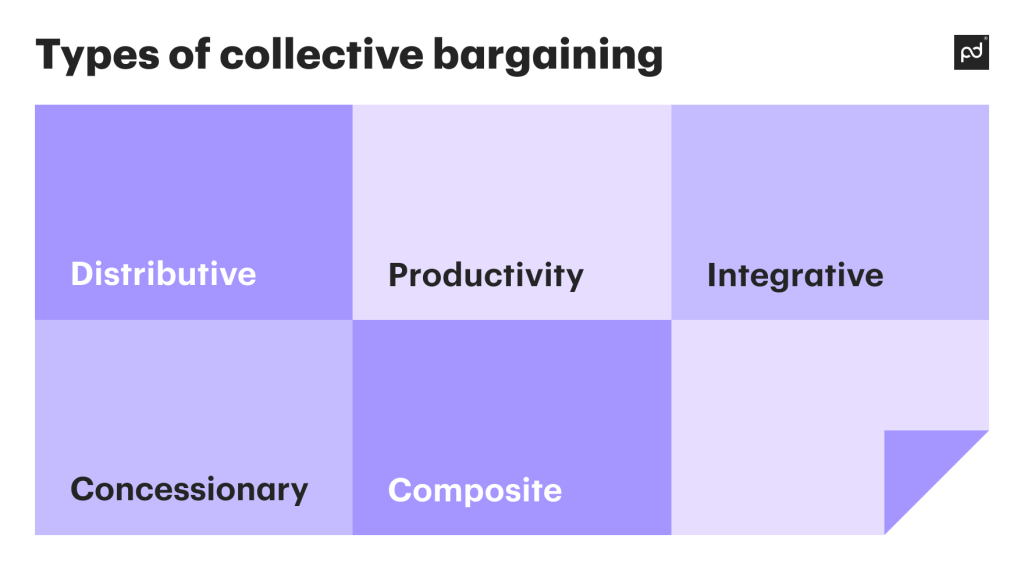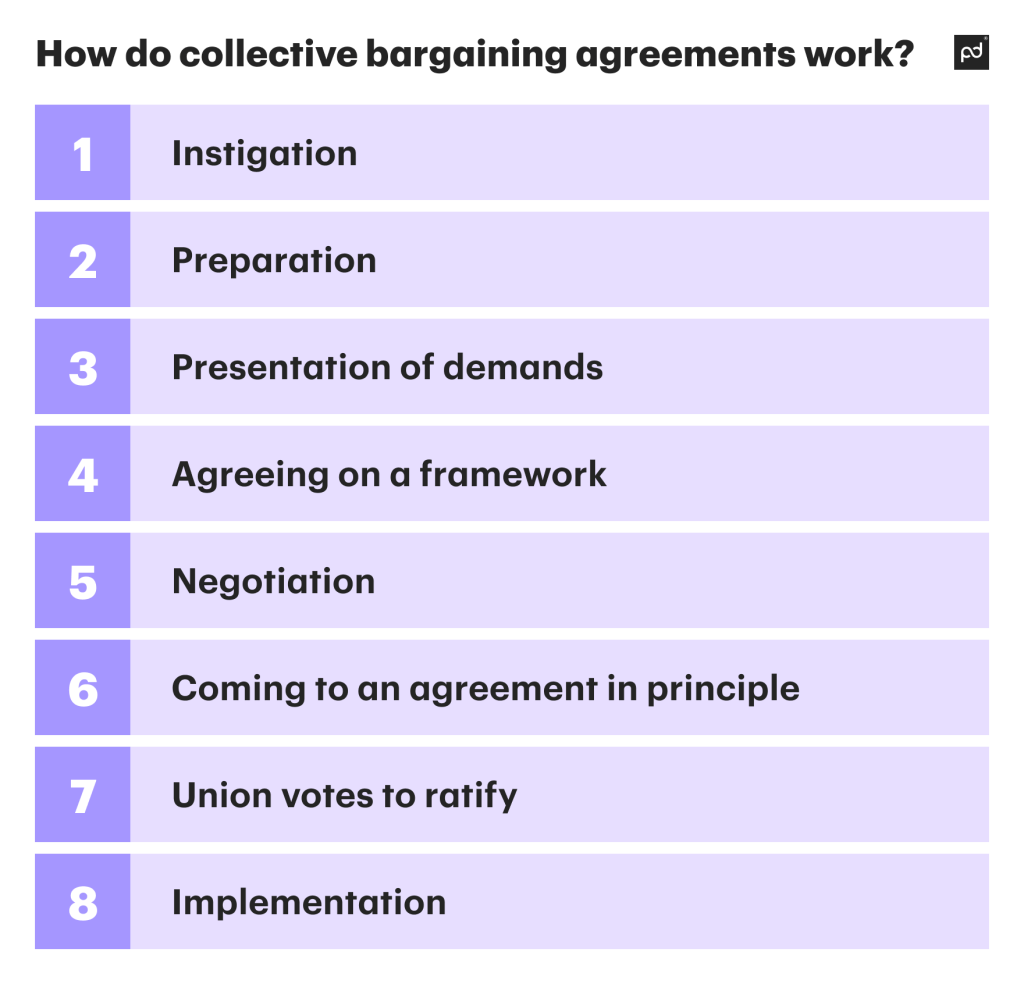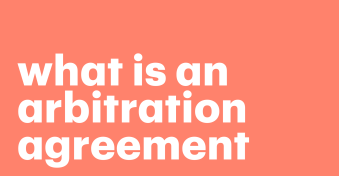Employees have the right to request better terms and conditions or wages.
The best way for them to achieve these is often through collective bargaining.
The outcome of this process must be documented using a collective bargaining agreement.
Read on to learn more about collective bargaining and the importance of a collective bargaining agreement.
Key takeaways:
- Collective bargaining allows employees to negotiate with their employers en masse rather than on an individual basis.
- There are several types of collective bargaining, including distributive and integrative.
- Collective bargaining agreements can take months or even longer to be signed and implemented.
- They include things like wages, work schedules, overtime and parental leave.
- The whole process can be made simpler with a strong contract management system.
What is collective bargaining?
Employees can come together to negotiate the terms of their employment.
When workers organize to have discussions with their employer, this is a labor union.
It would be difficult for employers to negotiate with all their employees individually.
Thus, a union member represents employees during talks. This is the process known as collective bargaining.
Types of collective bargaining
Understanding the different types of collective bargaining is crucial for both employees and employers. Here are some of the most common.

Distributive bargaining
This kind of negotiation revolves around the financial recompense employees receive.
It seeks to increase this by distributing more company profits through wages or bonuses.
To be able to make such demands, employees need a strong union that has the backing of its members.
If negotiations don’t lead to movement from company leadership, they could call a strike.
This is when employees withhold their labor until they reach a settlement.
Productivity bargaining
This is also linked to wages.
Unlike distributive bargaining, however, there’s something in it for both parties.
Employees agree to changes in their working conditions in exchange for better compensation.
This could include things like changes to working hours or vacation days. The aim of the changes is to increase productivity and, in turn, boost profitability.
The union takes the position of understanding why leaders want these changes. But they argue that their members should receive extra compensation.
Integrative bargaining
Integrative bargaining is an attempt to find a settlement that suits all parties.
It’s a strategy to find a mutually beneficial way forward. The union and management will work together and compromise where necessary.
Concessionary bargaining
In times of financial strife, companies and unions must sometimes come together.
They try to find ways of securing jobs and keeping the business’s doors open.
This may mean workers must sacrifice benefits or accept lower wages.
They do this so more of their fellow employees can keep their jobs.
Composite bargaining
Not every negotiation is about wages. Composite bargaining focuses on a range of other issues.
Workplace safety, disciplinary processes, and corporate policies can become areas of disagreement. The negotiations center on resolving these issues.
The ultimate aim is to ensure good relations between employees and employers.
What is a collective bargaining agreement or CBA?
Through negotiation, employees and management can agree on a settlement.
They need to document any changes before they can come into force. That’s where a collective bargaining agreement (CBA) comes in.
What does CBA mean? It’s a legal document designed to ensure both parties stick to the agreement. It’s the outcome of those hard-won CBA negotiations.
A CBA can vary in length. If negotiations have focused on a small policy point, it can result in a short CBA. Sometimes collective bargaining centers on a range of topics.
It can result in entirely new employee contracts and a raft of new corporate policies. In these instances, CBAs can become quite substantial documents.

Collective Bargaining Agreement Template
Used 4937 times
Collective Bargaining Agreement Template makes a chore union part of connections between a worker and an employer. This assists the worker to safeguard their rights and the employer understands the employee’s needs.
Use this templateHow do collective bargaining agreements work?
There are several steps to the collective bargaining process.
Negotiations can go on for months before a CBA is signed and implemented.
Sometimes they go on for even longer. Let’s take a look at those steps but keep in mind that the process can vary.
The steps in summary:

Now we’ll examine each step in more detail. If you ever find yourself on either side of CBA negotiations, you should know this process.
Step 1: Instigation
An event will trigger the need for negotiation. This may originate internally or could be the result of external forces.
An example of an internal catalyst could be the firing of an employee.
If the wider workforce feels it was unjustified, they may feel their own job is at risk.
This could lead to demands for changes to the process.
Some events are out of the control of the employer.
Yet they could instigate a need for negotiation. Broader economic forces, such as inflation, can lead employees to demand higher wages.
Step 2: Preparation
Once it becomes clear that a negotiation is necessary, each party must prepare. The employer must choose someone to represent them.
This could be someone from upper management or a board member.
The employees need a representative too. This may be a colleague they choose collectively or a union representative.
The employees must also agree on a list of demands. They will meet and vote on their priorities.
If wage increases are being discussed, they’ll come up with a figure from which to negotiate.
If the dispute is about a point of policy, they’ll propose an alternative wording or that it be removed entirely.
Step 3: Presentation of demands
Representatives from each party will meet to discuss their demands.
If the employer accepts the request, a CBA can be drawn up and voted on. If not, then the process continues on to negotiations.
Step 4: Agreeing on a framework
Before negotiations can begin, the parties need to agree on the rules.
They’ll consider topics such as the times and dates, venue, and timeframes.
Some negotiations can be particularly fraught. In such cases, they may agree to a third-party mediator to chair discussions.
Step 5: Negotiation
With the framework agreed upon, negotiations can begin.
There are three categories of topics in collective bargaining negotiations. They are:
- Mandatory
- Permissive
- Illegal
Topics designated as mandatory must be discussed as governed by federal law.
This is the case if either party presents a proposal around them. This could include wages, promotions, or grievance procedures, among many others.
Permissive topics are optional. This would include internal company policies not governed by law.
Therefore, either party can refuse to discuss such subjects. This could, of course, lead to strike action or other disruption.
Illegal topics can’t be discussed during negotiations. This would be anything that contravenes state, local, or federal law.
Anything illegal included in a CBA would make it unenforceable.
For example, if employees wished to dispense with some sort of mandated work safety gear.
Negotiations succeed if they’re open and honest.
Both parties should respect and listen to one another. There will inevitably have to be compromise on both sides in order to come to an agreement.
Step 6: Coming to an agreement in principle
Eventually, representatives of both parties will come to an agreement. They then work together to write a draft CBA. Once complete, the representatives sign it.
They can do this on paper. Alternatively, they can write it electronically using a collective bargaining agreement template.
There may be a lot of details to work out. This method makes it easier to edit the document as necessary.
Step 7: Union votes to ratify
Once the representatives of both parties have approved the agreement, they present it to the union membership.
They will have some time to review it and discuss the key points.
After this period, they will have an opportunity to vote on whether or not it’s acceptable. If they deem it unacceptable, negotiations resume.
This may also lead to the resumption of strike action.
If it’s accepted, the collective bargaining agreement becomes ratified. It is now a legally binding contract.
Step 8: Implementation
The CBA will detail how and when it should be implemented.
Each party should be given enough time to prepare to make the prescribed changes.
Failure to do so could result in legal challenges against the employer. In cases where employees break the contract, internal disciplinary procedures could be activated.
This may result in suspension or dismissal.
What is the purpose of a collective bargaining agreement?
A CBA is intended to be evidence of a legally enforceable agreement.
This ensures both parties abide by the results of negotiations. It can be used in legal proceedings if the terms of the agreement were to be violated.
This is the reason it’s signed by the negotiating representatives. It shows that all parties have willingly entered into the agreement.
Using eSignature software is the best way to secure these signatures indefinitely. This protects the document if it were ever needed in court or a disciplinary hearing.
What’s included in a typical collective bargaining agreement
A collective bargaining agreement can include a great many subjects.
It’s applicable to anything that it’s possible to change in employee/employer relations. Let’s examine some of the more typical issues dealt with in these agreements.
Wages
It’s very common for negotiations to center on compensation. Employees have the right to earn as much as they can.
Businesses have a responsibility to provide shareholder value and make a profit. Finding a balance is not always easy.
Negotiations leading to an agreement allow each party to see the other side’s point of view.
Work schedules
Employees sometimes struggle to find a work/life balance.
The same can be said for business leadership. Collective bargaining can be a route to finding a compromise. One that’s beneficial to both parties.
Promotions
A collective bargaining agreement can sometimes address the process for promotions. Many workers would like to further their careers within a company.
In this way, a CBA can map out a path for advancement.
This is good for those that want to get on. It’s also good for the company as it incentivizes and motivates good work.
Overtime
It’s sometimes necessary for employees to work past their regular hours.
A CBA can establish whether they can expect extra compensation for doing so. If it does, it spells out exactly how much more they will receive.
Vacation time
Many workers value their vacation time.
It’s necessary to recharge their batteries to be productive when they return. A CBA can detail the number of vacation days employees can take each year.
Parental leave
Becoming a parent is equally joyful and stressful. New parents benefit from time away from work.
They can focus on their new arrival and prepare to become working parents. Collective bargaining can result in more generous arrangements for parents.
Processes and procedures
Businesses have a raft of processes and procedures for dealing with employees. Employees will sometimes take issue with the way things are done.
A CBA can be a reminder of how to conduct these processes. This results in a fairer workplace.
Some CBAs can be very focused on a particular issue.
Others may be dealing with complete employment contracts. In these cases, a new contract needs drawing up, as well as the CBA.
A free contract template makes this quick and easy.
Examples of collective bargaining agreements
Let’s see how collective bargaining agreements work with a hypothetical.
There’s an economic downturn. It’s exacerbated existing cash flow problems at Gladwell Food Co. They’re a food wholesaler with about a hundred employees.
The company is viable, and they can usually borrow money from the banks to pay their workforce.
This is sometimes necessary while they’re waiting for outstanding payments from clients.
The wider economic conditions are making it more difficult for them to borrow.
The company tells their employees that they need to make cuts. They propose cutting 15 jobs to save the company. This triggers talks with the labor union.
They enter into concessionary bargaining with the union. Both the company and the union want to avoid job losses.
They come to an agreement that sees the elimination of overtime and a wage cut for all employees. Management also agrees to a wage cut and to forgo their annual bonus for that financial year.
They draft a CBA, and the union puts it to a vote.
It is ratified out of a sense of solidarity between colleagues. The agreement has saved the company and the jobs of its entire workforce.
Create enforcement consistency with a CBA
A CBA is a contract.
Those who enter into one are bound by law to abide by its clauses.
As such, it needs to be a well-drafted document. PandaDoc has tools for negotiating contracts to make life easier for your business.
Disclaimer
PandaDoc is not a law firm, or a substitute for an attorney or law firm. This page is not intended to and does not provide legal advice. Should you have legal questions on the validity of e-signatures or digital signatures and the enforceability thereof, please consult with an attorney or law firm. Use of PandaDocs services are governed by our Terms of Use and Privacy Policy.


